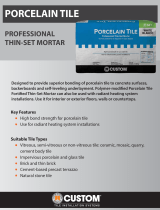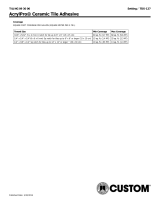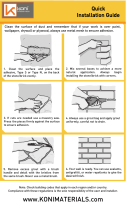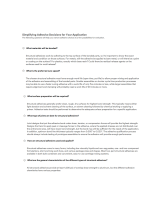Page is loading ...

8850 N.W. 79th Avenue Miami, Florida 33166 PH 800/826-6852 FAX 305/883-5591 www.jamoinc.com
hydrostatic pressure. Concrete slabs should have a
broomed or brushed finish to enhance the bond. Do not
sand flooring materials containing asbestos. Ambient
temperature, surfaces and materials should be maintained
at a temperature above 50° F (10° C) or below 100° F
(38° C) for 72 hours.
Plywood Substrates
Plywood floors, including those under resilient flooring,
must be built to industry standards. Deflection should not
exceed L/360. Smooth concrete surfaces, existing glazed
tile, terrazzo, or polished stone should be roughened or
scarified. Sheet vinyl must be well bonded and stripped of
old finish. Roughen the surface by sanding or scarifying,
rinse and allow to dry.
Expansion Joints
Expansion joints, control joints and cold joints should
never be bridged with setting material. They must be
brought through the tile and filled with an appropriate
elastomeric sealant.
Cutback Adhesive over Concrete
Adhesive layers must be removed as they reduce mortar
bond strength to cement surfaces. Use extreme caution
as adhesives may contain asbestos fibers. Do not sand or
grind adhesive residue, as harmful dust may result. Never
use adhesive removers or solvents, as they soften the
adhesive and may cause it to penetrate into the concrete.
Adhesive residue must be wet-scraped to the finished
surface of the concrete, leaving only the transparent
staining from the glue. Do a test bond area first, to
determine desirable results. Refer to the RFCI Pamphlet,
“Recommended Work Practices for Removal of Resilient
Floor Coverings” for further information.
Mixing
Thoroughly mix 6 quarts (5.68 L) clean, cool water and
50 lbs. (22.68 kg) of powder together to a smooth, paste
consistency. Mix by hand or use a low speed (150 – 200
RPM) 1/2" (13 mm) drill. Let slake or stand 5 – 10 minutes,
stir again and use. Stir occasionally to keep fluffy, but do
not add more water. When properly mixed, troweled ridges
will stand with no slump.
Multi-Purpose Flex has superior bond strength for setting
porcelain, glass and other non-porous tile to concrete
surfaces, backerboards and self-leveling underlayments.
Sets large porcelain tile over 12" x 12" (30 x 30 cm). Also
great for radiant heating system installations. Exceeds
ANSI A118.4 and A118.11 without the need for additives.
Basic Use
Bonds vitreous, semi-vitreous or absorptive tile including
ceramic, mosaic, quarry, porcelain and glass tile; precast
terrazzo; brick; mini-brick; gauged natural stone tile. For
interior or exterior floors, walls or countertops. Use white
mortar when installing light colored or translucent marble,
glass tile or when using light colored grout. When setting
moisture sensitive stone, tile or agglomerates, use
EBM-Lite™ Epoxy Bonding Mortar—100% Solids. Do
not use to install resin-backed stone. When setting glass
tile over 6" x 6" (15 x 15 cm) or dimensional stone larger
than 12" x 12" (30 x 30 cm), contact Technical Services
for recommendations.
Areas of Use
Apply over concrete, mortar beds, masonry, cement
backerboards, Portland cement, plaster, gypsum wallboard
(dry areas), existing ceramic tile, exterior grade plywood
(interior dry areas), sheet vinyl flooring, VCT, plastic
laminates or cutback adhesive.
Limitations
Do not bond directly to hardwood, Luan plywood, particle
board, parquet, cushion or sponge-back vinyl flooring,
metal, fiberglass, plastic or OSB panels.
Surface Preparation
General Surface Preparation
Surfaces must be structurally sound, clean, dry and free
from grease, oil, dirt, curing compounds, sealers, adhesives
or any other contaminant that would prevent a good bond.
Glossy or painted surfaces must be sanded, stripped and
cleaned of waxes, dirt or any contaminants. Concrete or
plaster must be fully cured and accept water penetration.
Concrete must be free of efflorescence and not subject to
MULTI-PURPOSE FLEX
POLYMER-MODIFIED THIN-SET MORTAR
SETTING PRODUCTS

8850 N.W. 79th Avenue Miami, Florida 33166 PH 800/826-6852 FAX 305/883-5591 www.jamoinc.com
FITNESS ARE HEREBY DISCLAIMED. The suitability of a
product for an intended use shall be solely up to the user.
Manufacturer assumes no liability for consequential
damages. Its liability shall in no event exceed the purchase
price of the materials supplied by it. No person has the
authority to change these items and there are no warranties
except herein stated.
Caution
Contains Portland cement. Wear rubber gloves and eye
protection. Avoid eye contact or prolonged contact with
skin. Wash thoroughly after handling. If eye contact occurs,
flush with water for 15 minutes. Consult a physician
immediately.
WARNING! Do Not Breathe Dust! This product contains
Free Silica which may cause cancer or delayed lung injury
(Silicosis). Wear approved respirator in dusty areas. See
Material Safety Data Sheet for detailed information.
KEEP OUT OF REACH OF CHILDREN. DO NOT TAKE
INTERNALLY. STORE IN COOL, DRY AREA.
Application
INSTALLATION TO CONFORM TO ANSI A108.5. Use
proper sized notch trowel to ensure 100% coverage under
tiles. Use a 1/4" x 3/8" x 1/4" (6 x 9.5 x 6 mm) square-notch
trowel when setting tile larger than 12" x 12" (30 x 30 cm).
Using flat side of trowel, apply skim coat of mortar to the
surface. Apply additional mortar with notched side of trowel
held at a 45° angle to the surface, combing in one direction.
Press tile firmly into place in a perpendicular motion across
ridges, moving back and forth. Perpendicular pressing
flattens ridges and closes valleys allowing maximum
coverage. With some tile, back buttering is advisable.
Adjust tile promptly and beat in with block and rubber
mallet. Mortar can be applied up to 1/4” (6 mm) thick after
beat in. For thicker applications, use a medium bed mortar.
Periodically pull up a tile and check the back to ensure
complete coverage with the adhesive. Do not spread more
material than can be tiled in 15 minutes or while material
has wet tack (sticky to the touch). If material has skinned
over (not sticky), recomb with notch trowel. If too dry,
remove and replace with fresh material. Material in bucket
will remain workable approximately 4 hours.
Coverage
90 - 100 sq. ft. per 50 lbs. (8.4 - 9.3 M
2
/22.68 kg) applied
with a 1/4" x 1/4" x 1/4" (6 x 6 x 6 mm) square-notch trowel.
60 - 70 sq. ft. per 50 lbs. (5.6 - 6.5 M
2
/22.68 kg) applied with
a 1/4" x 3/8" x 1/4" (6 x 9.5 x 6 mm) square-notch trowel.
Cleaning
Clean with water before material dries.
Curing and Grouting
Allow to dry for at least 24 hours before grouting or light
traffic depending upon temperature and humidity. Master
Color
®
Grout is recommended.
Warranty
Manufacturer warrants that should this product prove to be
defective material, it will replace the same or refund the
purchase price of the goods. THIS WARRANTY IS IN
PLACE OF ALL OTHER WARRANTS EXPRESS OR
IMPLIED. WARRANTIES OF MERCHANTABILITY AND OF
MULTI-PURPOSE FLEX
POLYMER-MODIFIED THIN-SET MORTAR
DSJ012 8/10R
Typical Value
Exceeds ANSI A118.4 and
A118.11 specifications
Open Time @ 70° F (21° C) 30 minutes
Adjustability @ 70° F (21° C) 30 - 35 minutes
Shear Bond Strength
Non-Vitreous Tile: 28 day dry cure
Bisque Tile 550 psi (38.7 kg/cm
2
)
Porcelain Tile 450 psi (31.6 kg/cm
2
)
Quarry Tile to Plywood 190 psi (13.4 kg/cm
2
)
SETTING PRODUCTS
Item Code Color Size Package
125133 Grey 50 pounds (22.68 kg) Bag
125003 White 50 pounds (22.68 kg) Bag
Technical Data
Ordering Information
/









